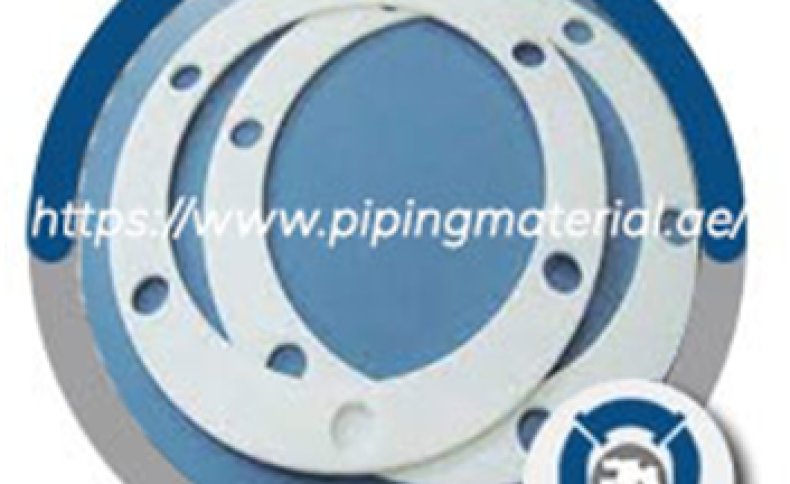What are PTFE gaskets used for?
February 2, 2023 - 0 COMMENTS

PTFE gaskets, also known as Teflon gaskets, are used in various applications because of their excellent chemical and temperature resistance properties. They are frequently utilised in the food, beverage, pharmaceutical, and chemical processing industries. PTFE gaskets can also be used in high-temperature applications, such as those in the automobile and aerospace sectors. One of the critical advantages of PTFE gaskets is that they are chemically inert and can resist a wide range of chemicals, including acids and alkalis. They also have a high-temperature range and can withstand temperatures up to 260°C (500°F).
PTFE gaskets are appropriate for outdoor applications because they resist UV radiation and corrosion. PTFE gaskets are also known for their low friction properties and dielectric strength, making them ideal for electrical applications. They can also be utilised when low compression settings and little creep are required. Another advantage of PTFE gaskets is that they can be easily cut and fabricated into custom shapes and sizes to fit specific applications. They can also be combined with other materials like glass or stainless steel to enhance their features.
Overall, PTFE gaskets are highly versatile and can be used in a wide range of applications due to their excellent chemical and temperature resistance properties and their ability to be fabricated into custom shapes and sizes.
PTFE gaskets
Why is the PTFE envelope gasket waterproof?
Tetrafluoroethylene is a synthetic fluoropolymer that is known as PTFE (polytetrafluoroethylene). It is resistant to a wide range of chemicals and has a very low coefficient of friction. PTFE is also known for its excellent electrical insulation properties, high thermal stability, and resistance to weathering. Due to these properties, PTFE is often used in applications where chemical resistance and a low coefficient of friction are required, such as in the manufacturing of gaskets and seals. PTFE envelope gaskets are designed to seal against liquids and gases in demanding applications. They are made by encasing a PTFE-filled core in a PTFE envelope. The PTFE envelope provides a barrier to liquids and gases, while the PTFE-filled centre offers a low coefficient of friction and excellent chemical resistance. The PTFE envelope gasket is waterproof because of its unique properties of PTFE. PTFE has a very low coefficient of friction and is highly chemically resistant, making it an ideal material for gaskets and seals. The PTFE envelope provides a barrier to liquids and gases, preventing them from penetrating the gasket.
The PTFE substance is also highly water and liquid resistant, making it an excellent option for situations where water resistance is crucial. Furthermore, the PTFE envelope gasket has a good compression recovery, which means it can maintain its seal even after compression. As a result, the PTFE envelope gasket is often used in applications where a high level of water resistance is required, such as in marine environments, chemical processing, and food and beverage processing. In summary, the PTFE envelope gasket is waterproof due to its unique properties of PTFE. PTFE is highly chemically resistant, has a low friction coefficient, and has high compression recovery. The PTFE envelope provides a barrier to liquids and gases, preventing them from penetrating the gasket. Additionally, the PTFE material is highly resistant to water and other beverages, making it an ideal choice for applications where water resistance is a crucial requirement.
What do tri-clamp gaskets do?
A tri-clamp gasket is an example of a gasket used to seal the connection between two pipes or fittings connected using a tri-clamp fitting. Tri-clamp fittings offer a safe, leak-proof seal that can handle high pressure and high temperatures, which makes them a popular choice in the food & beverage, pharmaceutical, and biotech sectors.
The gasket is typically made from silicone or other types of rubber, and it sits between the two pipes or fittings being joined together. The gasket helps to create a seal by filling any gaps or uneven surfaces between the pipes or fittings, preventing the escape of liquids or gases. It is crucial to ensure that a tri-clamp gasket is correctly placed and seated in the fitting before utilising one. This can typically be done by hand, although some fittings may require a clamp or other tool to ensure that the gasket is securely in place. Additionally, it is crucial to utilise the correct size gasket for the particular fitting. Using a too-small or too-large gasket can result in leakage or other problems. In addition, it’s also essential to ensure that the gasket is made of the correct material for the application, as different gasket materials are better suited for different environments, such as high-temperature or high-pressure applications.
How do you use a tri-clover gasket?
A tri-clover gasket, also known as a tri-clamp gasket, is a type of gasket used to seal the connection between two pipes or between a pipe and a fitting in a sanitary piping system. These gaskets are typically made of silicone or EPDM rubber and are used in food, beverage, and pharmaceutical processing applications. To use a tri-clover gasket, first ensure that the surfaces of the pipes or fittings to be connected are clean and free of debris. Next, place the gasket on the grooved end of one of the pipes or fittings, ensuring it is correctly seated in the groove. Then, align the other pipe or fitting with the first and clamp them together using a tri-clover clamp. Tighten the clamp until a secure seal is formed. It is important to note that the clamp should be tightened with a torque wrench to the appropriate torque specified by the manufacturer to ensure a proper seal. Also, you should regularly check the gasket for any damages or wear and replace it if necessary to maintain a good seal and prevent leaks.
Additionally crucial is choosing the right size gasket for your application. Tri-clover gaskets come in various sizes to fit different pipe and fitting sizes. Using the wrong size gasket can result in an improper seal, leading to leaks and other issues. It is also essential to clean the gasket properly before reusing it.
Is GST on imports expanded PTFE gasket refundable in Turkey?
The rules for GST refunds in Turkey may vary depending on the specific circumstances of the import and the intended use of the goods. It is best to consult with a tax professional or the Turkish Revenue Administration for detailed guidance on GST refunds for imported expanded PTFE gaskets. Additionally, It could be essential to check the trade agreement between Turkey and the country that the goods are imported from in case of a specific provision regarding GST or other taxes.
Can we manufacture tri-clamp envelope gaskets in India as cheaply as in China?
It is possible to manufacture tri-clamp envelope gaskets in India at a lower cost than in China. However, it will rely on several variables, including the price of labour, raw materials, and production techniques. One advantage India may have over China in terms of manufacturing costs is lower labour costs. In addition, India has a sizable and expanding manufacturing industry, raising its worldwide competitiveness. India also has a large domestic market for industrial products, which may help to keep costs down. However, it is essential to note that China has a well-established manufacturing infrastructure and a large pool of skilled workers, which allows them to produce goods at a lower cost than many other countries.
Additionally, China has strong government support for the manufacturing sector, which may make it difficult for other countries to compete. Ultimately, whether or not India can manufacture tri-clamp envelope gaskets as cheaply as China will depend on various factors, including the overall competitiveness of the Indian manufacturing sector, the cost of raw materials and labour, and the efficiency of manufacturing processes. Regulations, brand familiarity, and operation size will all play a role.


.png)










